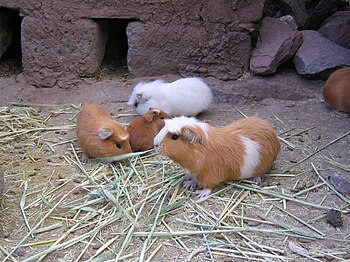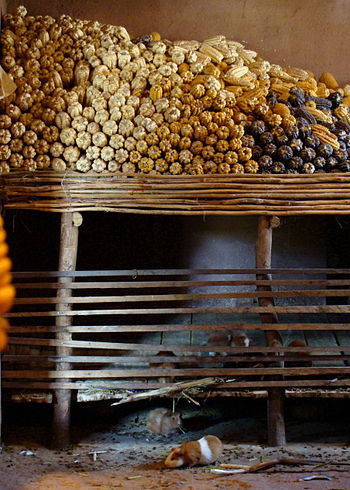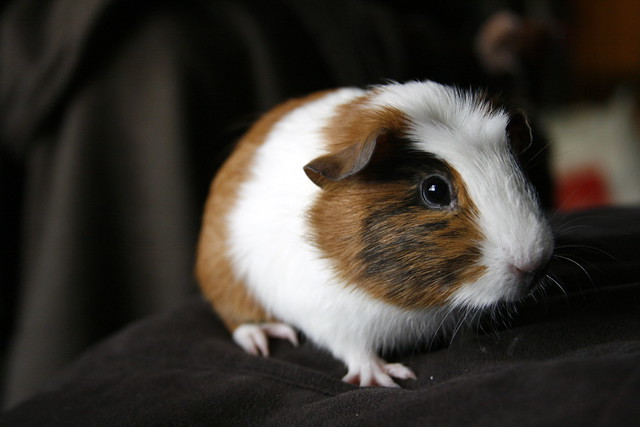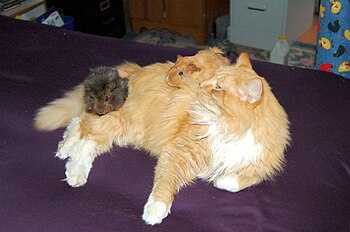(Original Title: Guinea Pig Care & Handling)
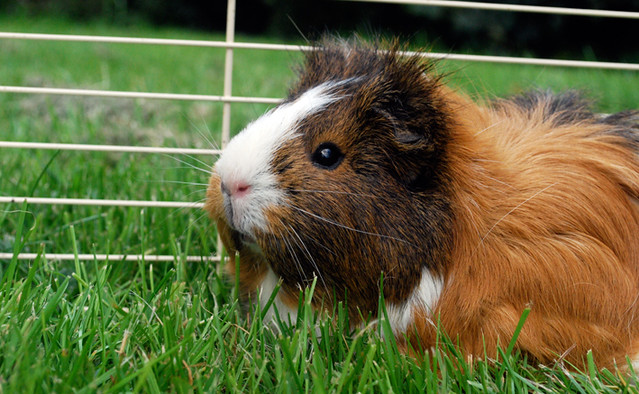 |
| Photo by picto:graphic |
What Guinea pigs Eat and Drink:
First off let's start off with what you should never feed you guinea pig:
-Potatoes and potato skins
-Iceberg lettuce (most other lettuce is okay)
-Rhubarb
-Beans
-Cauliflower
-Chocolate
Chocolate and potato skins and potatoes have been known to kill or make Guinea pigs sick. The other stuff is very unhealthy. If you are not sure about a food item you are going to feed you guinea pig then don't feed them it until you have researched further.
Now what to feed your guinea pig: Guinea pigs need a lot of fibre and vitamin C (because just like humans they cannot produce vitamin C and need to do bowel movements.
-Guinea pigs need and love hay, do to the fact that it provides a good source of fibre and guinea pigs need lots of fibre.
-Hay - the best type of hay for your Guinea pig is Timothy hay unless they are very young under 4 months, pregnant or nursing sows then use alfalfa-based hay. You should make sure there is always hay in the cage for your Guinea pig (it is best if it is not touching the ground so it does not get contaminated).
-Pellet food - one essential thing here is that you never feed theme any other type of pellet food then guinea pig food, so too the fact that guinea pig food contains vitamin C and others are not as healthy for them. Make sure you get a good brand of food because that is one of the main things guinea pigs eat, as in hay give them as much as they need usually a small handful per piggy, but if there is a lot leftover the next day then add less in the mornings, also if the bowl is constantly empty the next day then add more.
-Water - very important to make sure that their sippy bottle always has plenty of fresh cool water in it.
-Veggies and fruits - if your guinea pig does not get enough of these then it will not have enough vitamin C in its system which could cause scurvy. Most vegetables are good for your guinea pig(s) except of course the ones I mentioned earlier (again of course if you are not sure of something you are planning pm feeding your guinea pig look it up) some of the best fruits and veggies are apples, carrots, pear, and most lettuces (never iceberg), there are many more that are suitable. Some guinea pigs can be very picky about what they eat so make sure you introduce what you want to feed to them when they are still young.
Cage:
Guinea pig cages should not be looked at as a cage, they should be looked at as a home, because unlike dog cages were you put your dog when it sleeps or when you are out the guinea pig spends most of the time in its cage. So the cage should be at least 2.5 ft by 2.5 ft for one pig and for each additional pig you should as at least 2 ft by 2ft of cage size but bigger won't hurt. The walls should be at least 1 foot high. because guinea pigs natural habit when they are scared or startled is to run to shelter you should have a house in your guinea pig cage about twice the size of the pig and with an opening, it can just fit in, you need one house per pig.
Bedding:
Is the stuff that goes on the bottom of the cage, you should get a quality bedding like if not using this then make sure you are using one that isn't too strong smelling. DO NOT USE CEDAR WOODCHIPS; Guinea pigs are allergic to them so they can cause health problems. The Bedding shouldn't have to be more then 2cm thick, if you see the bottom of the cage after your pig has been running through it then add more after the next cleaning.
Cleaning:
You should clean the cage about once a week, that includes removing the guinea pig(s) putting it or them in a safe environment, for the time being, then remove the bedding and anything else wash the cage itself the house or houses sterilize the water bottle and food bowl dry everything, then put fresh bedding in then the cage then the food and attach the water bottle and finally the guinea pig(s) should only take 10-20 minutes.
Handling:
When you are removing the guinea pig from its cage be sure not to startle it because it will run away and hide. When picking up place one hand under its ribcage area and the other on its bottom, pick up slowly. Do not place your guinea pig on any high places that it can fall off or hurt its self. When holding the guinea pig be sure not to squeeze him be gentle and safe. Your guinea pig may be afraid of humans at first but if you are careful with him it won't be long till he/she will love to be picked up.
Exercise:
Guinea pigs like all animals need exercise, you can help them to get exercise by giving them a larger cage or having a large enclosed area for them to run around and play well you watch, they are usually more active when happy or in pairs.
Cleaning & Caring:
Guinea pigs need their nails trimmed and fur brushed, trimming there nails can be very difficult so make sure to have someone show or tell you how to do it before doing it yourself because you can hurt them if you do it wrong. If your guinea pig is smelly or greasy you can bath him bye filling up your sink with water, make sure his face stays dry. if you are using shampoo make sure to get it from a vet, if so then make sure to rinse it all out by taking soap-free water and pouring it gently on your guinea pig. Use a towel to dry him be very gentle to not hurt your piggy, never use a blow dryer because the heat can hurt guinea pigs.
Health:
If you see any health problems consult your local vet. this goes the same for any other pet on this website including Ferrets, Hamsters, Pet Mice, or Rabbits
|








